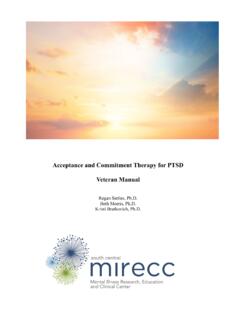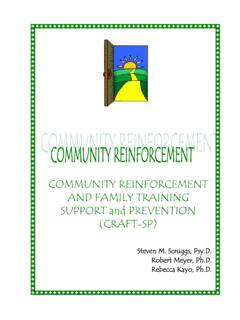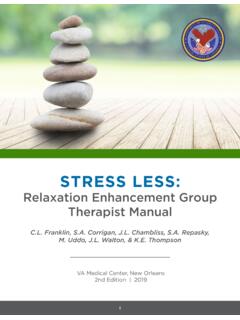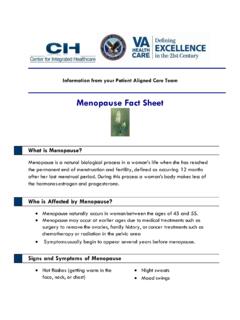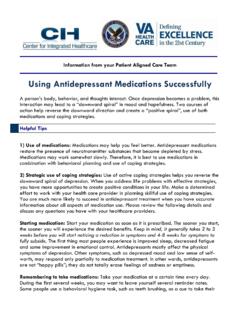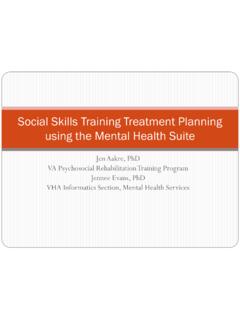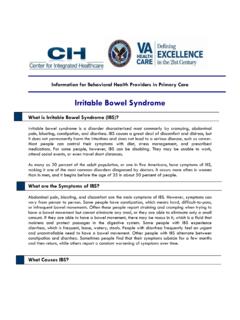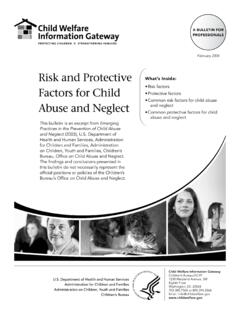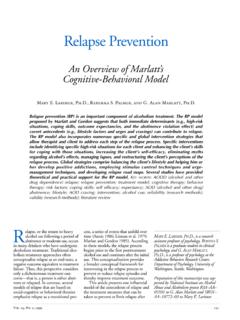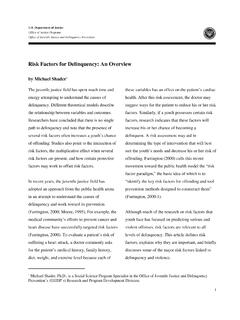Transcription of Documenting suicide risk assessment and management: …
1 Documenting suicide risk assessment and management: Making use of the evidence to facilitate decision making Lisa A. Brenner, PhD, ABPP VISN 19 Mental Illness Research Education and Clinical Center, University of Colorado, Denver, School of Medicine Seattle VAMC 9/2012 Disclosure This presentation is based on work supported, in part, by the Department of Veterans Affairs, but does not necessarily represent the views of the Department of Veterans Affairs or the United States Government. I think it took awhile before I realized and then when I started thinking about things and realizing that I was going to be like this for the rest of my life, it gives me a really down feeling and it makes me think like why should I be around like this for the rest of my life? - VA Patient/TBI Survivor suicide Risk assessment Refers to the establishment of a clinical judgment of risk in the near future, based on the weighing of a very large amount of available clinical detail.
2 Jacobs 2003 We assess risk Identify modifiable and treatable risk factors that inform treatment Simon 2001 Hal Wortzel, MD Take care of our patients We should also assess care of ourselves Risk management is a reality of psychiatric practice 15-68% of psychiatrists have experienced a patient suicide (Alexander 2000, Chemtob 1988) About 33% of trainees have a patient die by suicide Paradox of training - toughest patients often come earliest in our careers Hal Wortzel, MD Is a common language necessary to facilitate suicide risk assessment ? Do we have a common language? Case Example 1 A healthy 21-year-old female is brought by her boyfriend to the Emergency Department after telling him she ingested 4-6 regular strength acetaminophen [Tylenol] capsules (1300-1950 mg total dose). She reports no ill effects.
3 Lab tests done at the time of admission to the ED reported her acetaminophen level within the therapeutic range. Four hours later, lab tests reported levels within the low therapeutic range. During triage, she states that before she took the capsules, she was upset and wished she was dead. She feels better now and requests to go home. Suicidal ideation Death wish Suicidal threat Cry for help Self-mutilation Parasuicidal gesture Suicidal gesture Risk-taking behavior Self-harm Self-injury suicide attempt Aborted suicide attempt Accidental death Unintentional suicide Successful attempt Completed suicide Life-threatening behavior suicide -related behavior suicide The Language of Self-Directed Violence Identification of the Problem Clinical Research Public Health The Language of Suicidology Implications of the Problem Nomenclature (def.)
4 : a set of commonly understood widely acceptable comprehensive terms that define the basic clinical phenomena (of suicide and suicide -related behaviors) based on a logical set of necessary component elements that can be easily applied The Language of Self-Directed Violence A Solution to the Problem Silverman et al 2006 enhance clarity of communication have applicability across clinical settings be theory neutral be culturally neutral use mutually exclusive terms that encompass the spectrum of thoughts and actions Nomenclature: Essential Features Exhaustive Builds upon a nomenclature Further differentiates between like phenomena Classification System Essential Features Silverman et al 2006 Self-Directed Violence Classification System Lisa A. Brenner, Morton M. Silverman, Lisa M. Betthauser, Ryan E.
5 Breshears, Katherine K. Bellon, Herbert. T. Nagamoto, Type Sub-Type Definition Modifiers Terms Thoughts Non-Suicidal Self-Directed Violence Ideation Self-reported thoughts regarding a person s desire to engage in self-inflicted potentially injurious behavior. There is no evidence of suicidal intent. For example, persons engage in Non-Suicidal Self-Directed Violence Ideation in order to attain some other end ( , to seek help, regulate negative mood, punish others, to receive attention). N/A Non-Suicidal Self-Directed Violence Ideation Suicidal Ideation Self-reported thoughts of engaging in suicide -related behavior. For example, intrusive thoughts of suicide without the wish to die would be classified as Suicidal Ideation, Without Intent. Suicidal Intent -Without -Undetermined -With Suicidal Ideation, Without Suicidal Intent Suicidal Ideation, With Undetermined Suicidal Intent Suicidal Ideation, With Suicidal Intent Behaviors Preparatory Acts or preparation towards engaging in Self-Directed Violence, but before potential for injury has begun.
6 This can include anything beyond a verbalization or thought, such as assembling a method ( , buying a gun, collecting pills) or preparing for one s death by suicide ( , writing a suicide note, giving things away). For example, hoarding medication for the purpose of overdosing would be classified as Suicidal Self-Directed Violence, Preparatory. Suicidal Intent -Without -Undetermined -With Non-Suicidal Self-Directed Violence, Preparatory Undetermined Self-Directed Violence, Preparatory Suicidal Self-Directed Violence, Preparatory Non-Suicidal Self-Directed Violence Behavior that is self-directed and deliberately results in injury or the potential for injury to oneself. There is no evidence, whether implicit or explicit, of suicidal intent. For example, persons engage in Non-Suicidal Self-Directed Violence in order to attain some other end ( , to seek help, regulate negative mood, punish others, to receive attention).
7 Injury -Without -With -Fatal Interrupted by Self or Other Non-Suicidal Self-Directed Violence, Without Injury Non-Suicidal Self-Directed Violence, Without Injury, Interrupted by Self or Other Non-Suicidal Self-Directed Violence, With Injury Non-Suicidal Self-Directed Violence, With Injury, Interrupted by Self or Other Non-Suicidal Self-Directed Violence, Fatal Undetermined Self-Directed Violence Behavior that is self-directed and deliberately results in injury or the potential for injury to oneself. Suicidal intent is unclear based upon the available evidence. For example, the person is unable to admit positively to the intent to die ( , unconsciousness, incapacitation, intoxication, acute psychosis, disorientation, or death); OR the person is reluctant to admit positively to the intent to die for other or unknown reasons.
8 Injury -Without -With -Fatal Interrupted by Self or Other Undetermined Self-Directed Violence, Without Injury Undetermined Self-Directed Violence, Without Injury, Interrupted by Self or Other Undetermined Self-Directed Violence, With Injury Undetermined Self-Directed Violence, With Injury, Interrupted by Self or Other Undetermined Self-Directed Violence, Fatal Suicidal Self-Directed Violence Behavior that is self-directed and deliberately results in injury or the potential for injury to oneself. There is evidence, whether implicit or explicit, of suicidal intent. For example, a person with a wish to die cutting her wrist with a knife would be classified as suicide Attempt, With Injury. Injury -Without -With -Fatal Interrupted by Self or Other suicide Attempt, Without Injury suicide Attempt, Without Injury, Interrupted by Self or Other suicide Attempt, With Injury suicide Attempt, With Injury, Interrupted by Self or Other suicide Now that we are using a common language How should we be assessing risk?
9 Gutierrez and Osman, 2008 Elements of Useful assessment Tools Clear operational definitions of construct assessed Focused on specific domains (suicidality?) Developed through systematic, multistage process empirical support for item content, clear administration and scoring instructions, reliability, and validity Range of normative data available Basic Considerations Context specific schools, military, clinical settings Available resources time, money, staffing Infrastructure to support outcomes available referrals trained clinical staff in-house Self-Report Measures Advantages Fast and easy to administer Patients often more comfortable disclosing sensitive information Quantitative measures of risk/protective factors Disadvantages Report bias Face validity Evidence-Based Measures Suicidal Ideation - Beck Scale for suicide Ideation Depressive Symptoms Beck Depression Inventory II Hopelessness - Beck Hopelessness Scale Thoughts about the future - suicide Cognitions Scale History of suicide - Related Behaviors - Self-Harm Behavior Questionnaire Protective factors - Reasons for Living Inventory The purpose of this review is to provide a systematic examination of the psychometric properties of measures of suicidal ideation and behavior
10 For younger and older adults. Many of these measures have demonstrated adequate internal reliability and concurrent validity..It is therefore a serious problem that the predictive validity for most suicide measures has not been established. In fact, only a few instruments, such as the Scale for suicide Ideation and the Beck Hopelessness Scale, have been found to be significant risk factors for completed suicide . Although self-report measures are often used as screening tools, an adequate evaluation of suicidality should include both interviewer-administered and self-report measures. What are the key components? suicide focused clinical interview Psychological/Psychiatric Evaluation What is a suicide Risk Factor? A major focus of research for past 30 years factors Demographic ( , male gender, age over 65, Caucasian) Psychosocial ( , diagnosed serious mental illness, loss of significant relationship, impulsivity) Past history ( , suicide attempt, sexual or physical abuse)

